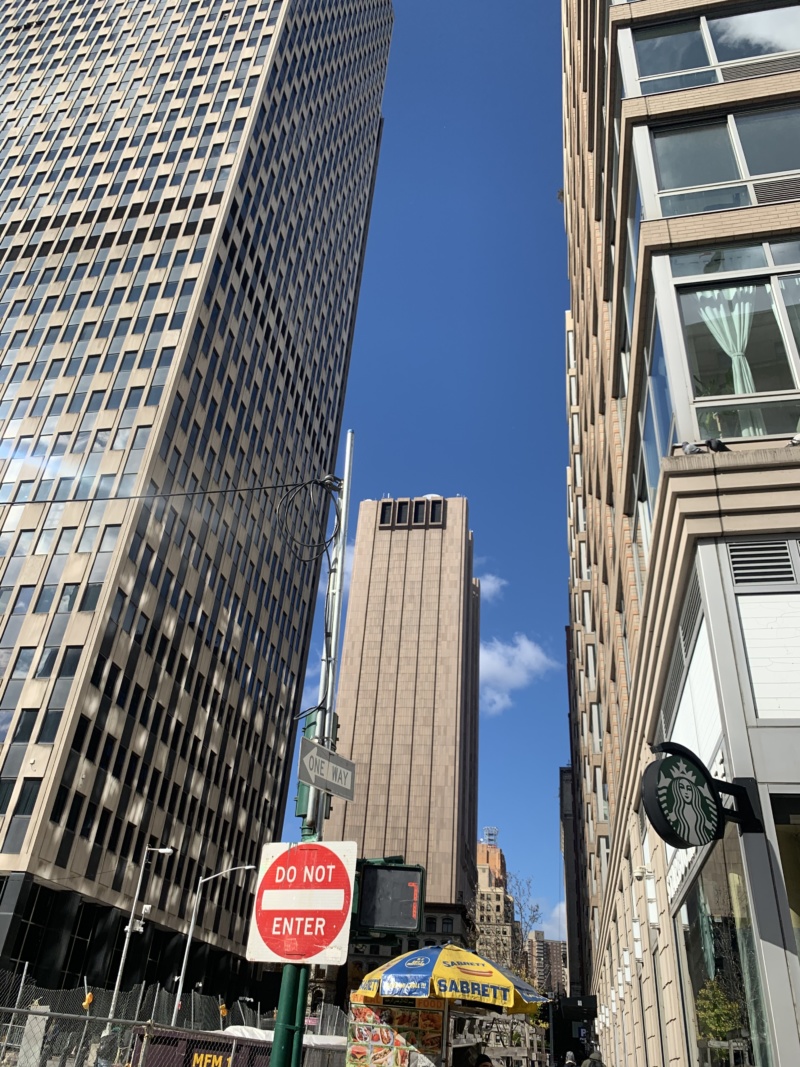
“Do you know the windowless skyscraper?” I ask a friend as we walk along East Broadway. “It’s one of my favorites.” She says no. I point diagonally southwest. “It’s over there, you just can’t see it from here ’cause there are other buildings in the way.” “Sure,” she says. I ask another friend, a lifelong New Yorker. He says he doesn’t know what I’m talking about: “I never look up when I walk.” Yeah right. Others shrug and say, “Uh huh, maybe.”
How could you miss it? It’s 550 feet of so much nothing—expansive planes of concrete smoothed over with Swedish granite, stretching unselfconsciously skyward, a slab of stone challenging the horizon. I bet people have friends more observant than mine, but, even still, in a 1982 introduction to “the TriBeCa scene” published in the Times (spoiler: it’s not SoHo!), Paul Goldberger writes that “though it looks more like a mammoth piece of equipment than a conventional building, it, in fact, blends into its surroundings more gracefully than does any skyscraper in this area.”
In the early 1970s, AT&T contracted John Carl Warnecke to design a new center to manage long-distance communication, located on a lot at 33 Thomas Street. Warnecke was an advocate for “contextual architecture,” believing that modern buildings should respond to their surrounding environment. What, then, does this say of the context below Canal? It is a downtown that since the 1970s has largely grown around this tower, now with all manner of new skyscrapers spiraling up, some with big names attached: Frank Gehry, Herzog & de Meuron, Kohn Pedersen Fox and further south now, David Adjaye. The 52-story Tribeca Tower luxury rentals across the street from 33 Thomas (its entrance and address are on Duane Street) almost seem to respond to the AT&T building’s form, though with not a touch of the latter’s elegance. Underneath that less conservatively fenestrated tower’s brick facade is just concrete, too. Designed to fade into the background, the Long Lines Building—as it is sometimes unofficially referred to—has become background itself.
No mere monument to modems, this megalith is a fortress. Built in the midst of the Cold War, the Long Lines Building was made strong enough to withstand an atomic blast, capable of protecting its equipment and any occupants, with enough food, water and generator fuel for 1,500 people to live for two weeks, off the grid: “A self-contained city,” as Warnecke called it. An above-ground bunker, it indexes fear; one can imagine a new society forming in the warren of cables inside, its members’ skin pallid, eyes muted from years of only artificial light. And what prime real estate it takes up! Perhaps fitting for a time when bunkers are the latest multimillionaire vogue. While nuclear war has yet to happen, faith in the building’s strength remains; following the destruction of the World Trade Center, telecom resources were relocated to the Long Lines Building, as well as to its stouter, Hell’s Kitchen sibling.
After a day and evening spent poring over photographs and building records as if they might reveal anything about this unrevealing structure, insomnia takes hold, as it so often does. I turn on the rebooted X-Files. A mysterious QR code discovered by the show’s FBI agent duo leads to a video of the tower at 33 Thomas, its great vents looming. “I opened an X-File on this building in the ‘90s,” Special Agent Mulder says. I read online that the building has figured elsewhere as well: in Winter Kills, Bridge of Spies, Mr. Robot. Always a symbol but never actually of the city; like the buildings of Augustín Hernández Navarro in Total Recall or Ricardo Bofill in Brazil, this tower seems to stand outside the present, even to those who see it every day—not in the future, exactly, but in a possible present just parallel to our own, floating hazily on the fringes of our vision. Online, 33 Thomas has been variously described as “ominous,” “terrifying,” a “tower of doom.” Some commentators are less fearmongering: “Not much to be seen from the outside,” one Google Maps review deadpans. Two stars.

All this sense of dread and doom—but what is the threat? According to The Intercept, which along with Field of Vision parse materials leaked by Edward Snowden, other government documents and Warnecke’s plans, in addition to conducting interviews, 33 Thomas Street may very well be a major center of NSA spying operations. Another Google review: “Stop stealing ma brain.”
I’ve talked mostly of its outside, of this massive, secretive structure as exteriority, but what of its innards? I hear it has 18-foot ceilings. 550 feet and just 29 floors. Lots going on below ground, too. Online I can find pictures only as recent as 1992. I ask various people in architecture and in architecture journalism if they think I can get in. Absolutely not is the consensus.
“Hi Jim, I’m a New York-based art and architecture writer…” “Hi Megan,” “Hi Geoff.” So many emails, all of them unanswered, “Hi, my name is Drew Zeiba, I’m calling…” No response. I decide to walk over. There are two people, the most I’ve ever seen, standing by a bicycle in the all-stone “public patio,” which is wrapped with a foreboding fence, its pointed tops turned out like at an airport or a graveyard. I climb up the tower’s steps for the first time, my legs heavy as if leadened by the strength of the structure’s own gravity. I feel like I am ascending a pyramid. I do not know what communion I might expect.
The glass doors are so dirty one can barely see through. I buzz the intercom, the design of which looks like it hasn’t been updated since 1974. No noise. I try to walk through one of the revolving doors even though there’s a red light next to it. Locked, clearly. A security guard comes to the door labeled “EMERGENCY EXIT ONLY” and cracks it open just enough to show his face. It’s a particularly harsh, bright, blue day outside but behind him is a murky halogen yellow, like somewhere deep underground, deep back in time. He looks me over, distrustfully. I try asking some questions about the building, if he knows anyone I can talk to about it, if I can at least see the lobby. “No,” over and over, the only word he says. The door closes. On the silver AT&T sign set into the granite cornerstone outside, someone has scrawled “STOP SNITCHING.”
Contextual architecture: 33 Thomas’s context is one of paranoia and control. The FBI is nearby. The Department of Homeland Security, as well. The IRS. The courts. The police. Not half a mile away is the city jail, often called The Tombs, and just a bit east of there, the federal prison. Some of these buildings figure few windows too, though not so totally, and because of that, perhaps not so honestly.
A monument to communication, 33 Thomas is also a monument to camouflage. It is so often in view that no one seems to see it. This is hardly a paradox; it is by design. The building’s central irony—that it is so totally opaque yet dedicated to connection—could never be better distilled than in this present moment. The networks that we rely on to communicate, work, play—accessible at all times from laptops and mobile phones and increasingly present in tools and toys from Amazon Alexas to “smart” refrigerators—open us up to all kinds of surveillance from the government and from private companies hungry for “personal” data. It’s a logic of surveillance that has pervaded our psyches, making it easy for us to treat ourselves as images to be circulated, our own front-facing cameras constantly lurking in hands and pockets.
Our private transmissions are now a public matter, managed by systems obscure to most of us, perhaps even by devices in this building. Warnecke wanted to design a “skyscraper to be inhabited by machines,” but what building now isn’t? While primarily housing technology for telephony, the Long Lines Building reminds us that ubiquitous communication technology is not some ethereal thing—it exists physically and our networked lives travel along a vast physical substrate. The internet is infrastructure and it shapes our cities.
One can imagine a future where this building stands long after our “connected” society is gone. What would future archaeologists think of this temple? What might they read of us by way of this insistently present architectural void? As night falls and glass panes around the city begin to glow, 33 Thomas goes dark, save for the few blinking red bulbs up top. It wants for no attention. Walking by, some report they can hear a hum.









 in your life?
in your life?